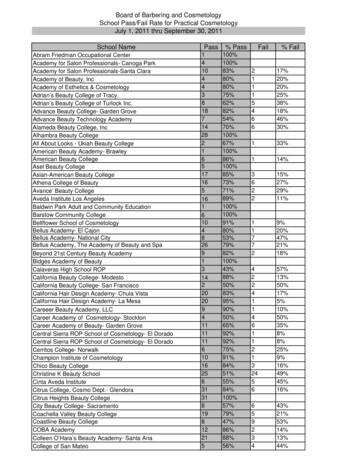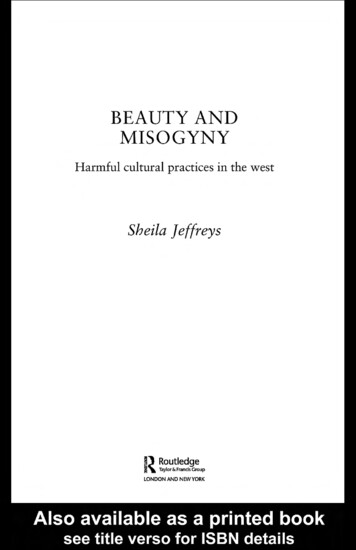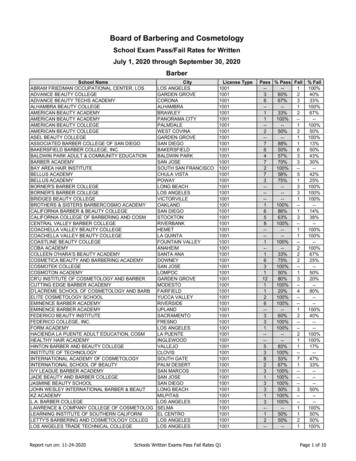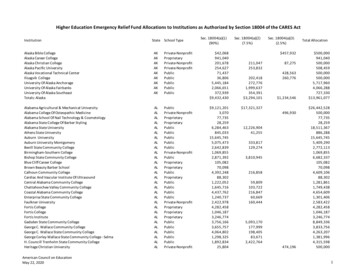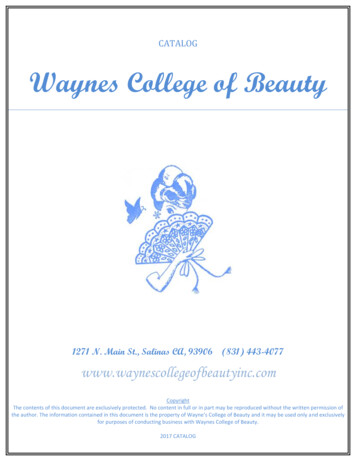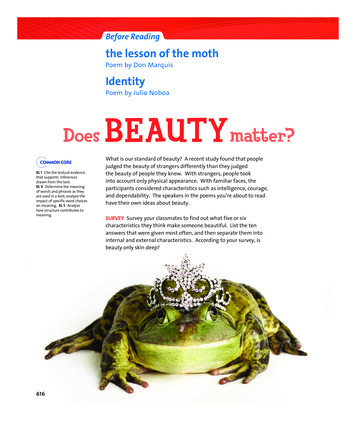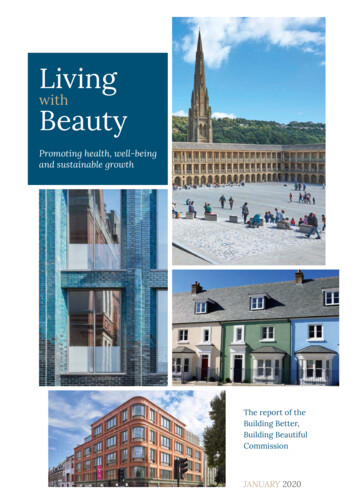
Transcription
LivingwithBeautyPromoting health, well-beingand sustainable growthThe report of theBuilding Better,Building BeautifulCommissionJANUARY 2020
Living with BeautyCONTENTS1. Our proposals 2. What we’ve done 16Part I – Our report 83. Ask for beauty 4. How do we want to live? 5. What should be done? 92635Part II – Our recommendations 546.7.8.9.10.11.12.Planning: create a predictable level playing field 55Communities: bring the democracy forward 74Stewardship: incentivise responsibility to the future 81Regeneration: end the scandal of ‘left-behind’ places 89Neighbourhoods: create places not just houses 99Nature: re-green our towns and cities 105Education and skills: promote a wider understanding ofplacemaking 11213. Management: value planning, count happiness,procure properly 118Part III – Conclusion 13014. What next: from vicious circle to virtuous circle 131Appendices 14015. Terms of reference 16. Commission, advisers and acknowledgements 17. Research 18. Case Studies 19. Glossary 20. Picture credits 140141145164168171i
“Like the pleasure of friendship, the pleasure in beauty is curious:it aims to understand its object, and to value what it finds.”Sir Roger Scruton FBA FRSL27 February 1944 – 12 January 2020ii
Malmesbury, Wiltshireiii
EXECUTIVE SUMMARYIn this report we propose a new development and planningframework, which will: Ask for Beauty Refuse Ugliness Promote StewardshipAsk for Beauty.We do not see beauty as a cost, to be negotiated away once planningpermission has been obtained. It is the benchmark that all newdevelopments should meet. It includes everything that promotes a healthyand happy life, everything that makes a collection of buildings into a place,everything that turns anywhere into somewhere, and nowhere into home.So understood beauty should be an essential condition for the grant ofplanning permission.Refuse Ugliness.People do not only want beauty in their surroundings. They are repelledby ugliness, which is a social cost that everyone is forced to bear. Uglinessmeans buildings that are unadaptable, unhealthy and unsightly, and whichviolate the context in which they are placed. Such buildings destroy thesense of place, undermine the spirit of community, and ensure that we arenot at home in our world.iv
Promote Stewardship.Our built environment and our natural environment belong together.Both should be protected and enhanced for the long-term benefit ofthe communities that depend on them. Settlements should be renewed,regenerated and cared for, and we should end the scandal of left-behindplaces, where derelict buildings and vandalised public spaces drivepeople away. New developments should be regenerative, enhancing theirenvironment and adding to the health, sustainability and biodiversityof their context. For too long now we have been exploiting and spoilingour country. The time has come to enhance and care for it instead. Ourrecommendations are designed to ensure that we pass on to futuregenerations an inheritance at least as good as the one we have received.We advocate an integrated approach, in which all matters relevant toplacemaking are considered from the outset and subjected to a democraticor co-design process. And we advocate raising the profile and role ofplanning both in political discussions and in the wider debate concerninghow we wish to live and what kind of a country we want to pass on.Our proposals aim for long-term investment in which the values that matterto people – beauty, community, history, landscape – are safeguarded. Henceplaces, not units; high streets, not glass bottles; local design codes, notfaceless architecture that could be anywhere. We argue for a stronger andmore predictable planning system, for greater democratic involvement inplanning decisions, and for a new model of long-term stewardship as theprecondition for large developments. We advocate a radical programme forthe greening of our towns and cities, for achieving environmental targets,and for regenerating abandoned places. The emerging environmental goals– durability, adaptability, biodiversity – are continuous with the pursuit ofbeauty, and the advocacy of beauty is the clearest and most efficient wayforward for the planning system as a whole.v
Living with Beauty’We all want beauty for the refreshment of our souls.’OCTAVIA HILL (1883)‘Human society and the beauty of nature are meant to beenjoyed together.’EBENEZER HOWARD (1898)‘to secure the home healthy, the house beautiful, the townpleasant, the city dignified and the suburb salubrious.’AIMS OF THE PLANNING ACT (1909)‘A happy awareness of beauty about us should and could bethe everyday condition of us all.’CLOUGH WILLIAMS-ELLIS (1928)
Living with Beauty‘Today to talk of beauty in policy circles risks embarrassment:it is felt both to be too vague a word, lacking precision andfocus and, paradoxically given its appeal by contrast withofficial jargon, elitist. Yet in losing the word ‘beauty’ we havelost something special from our ability to shape our presentand our future.’FIONA REYNOLDS (2016)‘Some housebuilders believe they can build any old crap andstill sell it.’SENIOR EXECUTIVE IN HOUSING AND DEVELOPMENTINDUSTRY SPEAKING TO THE COMMISSION (2019)‘New places are designed by the wheelie bin operators.’PARTICIPANT IN A COMMISSION WORKSHOP (2019)
Timekeeper’s Square, Salford
Living with Beauty1.Our proposalsWe naturally aim for beauty in our everyday lives, and many people arepuzzled that we seem to have lost the art of creating beauty in our builtenvironment. All around us we see ugly and unadaptable buildings, decayingneighbourhoods and new estates that spoil some treasured piece ofcountryside or are parasitic on of existing places not regenerative of them.Clearly, we must change the incentives. Beauty must become the naturalresult of working within our planning system. To achieve this result, wepropose three aims for the system as a whole:Ask for Beauty. Beauty includes everything that promotes a healthy andhappy life, everything that makes a collection of buildings into a place,everything that turns anywhere into somewhere, and nowhere into home.It is not merely a visual characteristic, but is revealed in the deep harmonybetween a place and those who settle there. So understood, beauty shouldbe an essential condition for planning permission.Refuse Ugliness. Ugly buildings present a social cost that everyone isforced to bear. They destroy the sense of place, undermine the spirit ofcommunity, and ensure that we are not at home in our world. Uglinessmeans buildings that are unadaptable, unhealthy and unsightly and whichviolate the context in which they are placed. Preventing ugliness should be aprimary purpose of the planning system.Promote Stewardship. Our built environment and our natural environmentbelong together. Both should be protected and enhanced for the longterm benefit of the communities that depend on them. Settlements shouldbe renewed, regenerated and cared for, and we should end the scandal ofabandoned places, where derelict buildings and vandalised public spacesdrive people away. New developments should enhance the environmentin which they occur, adding to the health, sustainability and biodiversityof their context.Those three aims must be embedded in the planning system and in theculture of development, in such a way as to incentivise beauty and deterugliness at every point where the choice arises. To do this we make policyproposals in the following areas:1. Planning: create a predictable level playing field2. Communities: bring the democracy forward3. Stewardship: incentivise responsibility to the future4. Regeneration: end the scandal of left behind place5. Neighbourhoods: create places not just houses6. Nature: re-green our towns and cities7. Education: promote a wider understanding of placemaking8. Management: value planning, count happiness, procure properly1
Living with BeautyEIGHT PRIORITIES FOR REFORM 2Planning: create a predictable level playing field. Beautifulplacemaking should be a legally enshrined aim of the planningsystem. Great weight should be placed on securing these qualitiesin the urban and natural environments. This should be embeddedprominently as a part of sustainable development in the NationalPlanning Policy Framework (NPPF) and associated guidance, as wellas being encouraged via ministerial statement. Local Plans shouldgive local force to this national requirement, defining it throughempirical research, including surveying local views on objectivecriteria. Schemes should be turned down for being too ugly and suchrejections should be publicised. We have one of the most adversarialand litigious planning systems and one of the most concentrateddevelopment markets in the world. We need a clearer approach toreduce planning risk and to permit a greater range of small firms,self-build, custom-build, community land trusts and other marketentrants and innovators to act as developers. In this way our planningsystem will better respond to the preferences of people as a whole,
Living with Beautywithin a more predictable framework. This needs to be accompaniedby greater probability of enforcement and stricter sanctions whenthe rules are broken. Communities: bring the democracy forward. Local councils needradically and profoundly to re-invent the ambition, depth andbreadth with which they engage with neighbourhoods as theyconsult on their local plans. More democracy should take place at thelocal plan phase, expanding from the current focus on consultation inthe development control process to one of co-design. Having shorter,more powerful and more visual local plans informed by local views(‘community codes’) should help engender this; but councils willalso need to engage with the community, using digital technologyand other available resources. The attractiveness, or otherwise, ofthe proposals and plans should be an explicit topic for engagement,rather than being swept aside as of secondary importance. Beautyshould be the topic of an ongoing debate between the public and theplanners, with the developers bound by the result. Stewardship: incentivise responsibility to the future. Our proposalsaim to change the nature of development in our country. In the placeof quick profit at the cost of beauty and community, we aim for longterm investment in which the values that matter to people – beauty,community, history, landscape – are safeguarded. Hence places, notunits, high streets not glass bottles, local design codes, not facelessarchitecture that could be anywhere. At present elements of the legaland tax regimes create a perverse (and unintended) bias in favourof a short-term site-by-site approach as opposed to a longer-termstewardship model. To change this we must confront legal and fiscalobstacles at the highest level and create a new ‘stewardship kitemark.’ Regeneration: end the scandal of ‘left-behind’ places. Too many placesin this country are losing their identity or falling into dereliction.They are noisy, dilapidated, polluted or ugly, hard to get aboutin or unpleasant to spend time in. Such places create fewer jobs,attract fewer new businesses and have less good schools. They donot flourish. Government should commit to ending the scandal of‘left-behind’ places. We need to ask ‘what will help make these goodplaces to live?’ It is never enough to invest in roads or shiny ‘big box’infrastructure. Development should be regenerative not parasitic.A member of Cabinet should be responsible for ensuring that newplaces reach the right standards, co-ordinating perspectives betweenthe ‘triangle’ of housing, nature and infrastructure. At the localcouncil level there should be a Chief Placemaker in every seniorteam and a member of the local Cabinet who has responsibility forplacemaking. Government should align VAT on housing renovation3
Living with Beautyand repair with new build, in order to stop disincentivising there-use of existing buildings. Brownfield sites should be promotedover greenfield sites, as targets for development. The strategy forhigh streets should aim to make high streets attractive places tolive and spend time in; and it should respond flexibly within a clearframework to changing patterns of demand.4 Neighbourhoods: create places not just houses. Too much of what webuild is the wrong development in the wrong place, either drive-tocul-de-sacs (on greenfield sites) or overly dense ‘small flats in bigblocks’ (on brownfield sites). We need to develop more homes withinmixed-use real places at ‘gentle density’, thereby creating streets,squares and blocks with clear backs and fronts. In many ways this isthe most challenging of our tasks, which is to change the model ofdevelopment from ‘building units’ to ‘making places’. Nature: re-green our towns and cities. Urban development shouldbe part of the wider ecology. Green spaces, waterways and wildlifehabitats should be seen as integral to the urban fabric.The government should commit to a radical plan to plant two millionstreet trees within five years, create new community orchards,plant a fruit tree for every home and open and restore canals andwaterways. This is both right and aligned with the government’s aimto eradicate the UK’s net carbon contribution by 2050. It should dothis using the evidence of the best ways to improve well-being andair quality. Green spaces should be enclosed and either safely privateor clearly public. The NPPF should place a greater focus on access tonature and green spaces – both existing and new – for all new andremodelled developments. Education and skills: promote a wider understanding of placemaking.Our evidence gathering and discussion have discovered widespreadagreement on the need to invest in and improve the understandingand confidence of professionals and local councillors. Crucial areasinclude placemaking, the history of architecture and design, popularpreferences and (above all) the associations of urban form and designwith well-being and health. The architectural syllabus should beshorter and more practical, and the government should considerways of opening new pathways into the profession. Management: value planning, count happiness, procure properly.Planning has undoubtedly suffered from budget cuts over the lastdecade, with design and conservation expertise especially suffering.By having a more rules-based approach, by moving the democracyforward, by using clearer form-based codes in many circumstances,by limiting the length of planning applications and by investing indigitising data entry and process automation, it should be possible
Living with Beautyto free up resources. We don’t pretend this profound process ofre-engineering will be easy. There is also a crucial need to changethe corporate performance targets for Homes England, and thehighways, housing and planning teams in central government andcouncils. They should be targeted on objective measures for wellbeing, public health, nature recovery and beauty (measured inter aliavia popular support). We should be measuring quality and outcomesas well as quantity. Finally, there is an urgent need to makes changesto the procurement targets, process and scoring within central andlocal government and, above all, Homes England. Until recentlythe sale processes of Homes England and other public bodies havelargely failing to take adequate account of any metrics of quality.This urgently needs to change if the state is not to be effectivelysubsidising ugliness.We won’t be able to achieve all these changes overnight (in chapter 14 weset out a possible timeframe of implementation). However, some could beimplemented very readily. While we have been working the government haspublished its welcome National Design Guide and its guidance documentDesign: process and tools, partially fulfilling our first policy proposal.The evidence shows that a planning system and development market thathad evolved in the ways we set out in this report would tend to encouragebetter public health, happier people, and more sociable communities. Itwould also help to end the scandal of ‘left-behind’ places whilst restoringthe place of nature in the urban environment to the benefit of our lungs andour mental health. The polling and pricing data strongly suggest that sucha move would be welcomed by our fellow citizens thus helping break out ofthe vicious circle of poor development and opposition to new homes.That would be a good thing for those who are already well housed, for themany who have yet to find somewhere affordable to live in, and for oursociety as a whole so that it can be more prosperous and truly inclusive. Weshould again aspire, with Clough Williams-Ellis, for ‘a happy awareness ofbeauty about us’ to be ‘the everyday condition of us all.’5
Living with Beauty2.6What we’ve done
Living with BeautyCOMMISSION VISITS TO EVERYCORNER OF ENGLAND7
Part IOur report
Living with Beauty3.Ask for beautyIt is not often that a government adopts beauty as a policy objective. Butsuch is the remit of this Commission, and we fully endorse the thinking thathas led to it. It is widely believed that we are building the wrong things, inthe wrong places, and in defiance of what people want. A comprehensiverecent study agrees, arguing that about three quarters of new housingdevelopments are mediocre or poor.1 At a time when there is an acuteshortage of homes, there is therefore widespread opposition to newdevelopments, which seem to threaten the beauty of their surroundings andto impose a uniform ‘cookie cutter’ product that degrades our natural andbuilt inheritance. People want to live in beautiful places; they want to livenext to beautiful places; they want to settle in a somewhere of their own,where the human need for beauty and harmony is satisfied by the view fromthe window and a walk to the shops, a walk which is not marred by pollutedair or an inhuman street. But those elemental needs are not being met bythe housing market, and the planning system has failed to require them.The Commission on building beautifully was set up at the end of 2018,asking us to review the planning system that has regulated construction inour country over the last hundred years. Ours is a discretionary system. Theright to build has been nationalised. However, it does not proceed by topdown control from government, but by the granting of permissions decidedlocally. This allows a voice to the many interests involved, including theinterests of neighbours, and reflects the historical origins of our legislation,largely introduced under pressure from civic associations motivated bythe desire to protect our natural and architectural legacy from thoughtlessdestruction in the wake of the industrial revolution. It has also meant that,in comparison with many other countries, the planning process as we knowit is both uncertain in its outcome and unclear in what it permits, involvinghigh risk for the developer and sparking often fierce resistance fromlocal communities.Large estates of low-quality housing naturally arouse opposition fromthose whose amenities and property-values they threaten, and preciousaspects of our built environment and countryside give rise to a strongdesire to protect them from changes that might spoil them. The cumulativeeffect of this, together with a rise in litigation from developers, has been astagnation in the planning process, and a sense that – despite the greatlyincreased wealth that this country now enjoys, in comparison with whatwas enjoyed by our predecessors in the early 20th century – we are buildingless beautifully than they, and indeed littering the country with built debrisof a kind that nobody will want to conserve. What has gone wrong, andhow can we change it? Those were the questions before the Commission,and this report is our answer to them. It is not the final answer; but it isthe first step towards understanding the direction in which our planningpolicy should go.9
Living with BeautyBeauty is not just a matter of how buildings look (though it does includethis) but involves the wider ‘spirit of the place’, our overall settlementpatterns and their interaction with nature. It involves both the visualcharacter of our streets and squares, and also the wider patterns of howwe live and the demands we make on our natural environment and theplanet. We should therefore be advancing the cause of beauty on threescales, promoting beautiful buildings in beautiful places, where they are alsobeautifully placed.BEAUTY AT THREE SCALESBeautifully placed(sustainable settlement patternssitting in the landscape)Beautiful places(streets, squares and parks,the "spirit of place")Beautiful buildings(windows, materials,proportion, space)This means accepting that new development should be designed to fit intothe life and texture of the place where it occurs; and also that it shouldaim to be an improvement of that place, regenerative not parasitic, anillustration of the way in which a new street may be more beautiful than thebuildings or fields that preceded it.10
Living with BeautyNew development may be the cause of ugliness; but it can also be the cureWe need to turn our planning system round, from its existing role as ashield against the worst, to its future role as a champion of the best.Although British people do not talk much about ‘beauty’, their lives revealthat they are prepared to make great sacrifices for the sake of it. This isclear in the decisions they make collectively. The Green Belt, the Areas ofOutstanding Natural Beauty, the listed building system and the conservationareas are vastly expensive in terms of the development that we foregoin order to maintain them. And yet they command near-universal publicsupport. Much money could be made by concreting over the Chilternsand the South Downs, by replacing our historic centres with tower blocks,and by crowding houses onto every ridgeline in the Lake District. Butmost people believe that the beauty of our country is more precious, andthat the financial sacrifice is unquestionably worth it. How else do weexplain the existence of the National Trust, with nearly 6 million members,the Campaign to Protect Rural England, the Civic Trusts and the longhistory of civic-inspired town planning movements, culminating in theRoyal Town Planning Institute (RTPI) and the Town and Country PlanningAssociation (TCPA) today?Many of the things that make settlements beautiful also make them healthy,happy and sustainable. A beautiful place is a place in which people wish towalk, rather than a place that the car helps them to avoid. It is a place inwhich they enjoy spending time with one another. Beautiful buildings areconserved and adapted, like the Victorian public buildings that survive longafter their initial uses have gone. Ugly buildings are torn down and replaced,at a huge cost in terms of ‘embodied energy’.11
Living with BeautyRecycling buildings in Manchester12
Living with BeautyIn general, all that we seek by way of human health and environmentalsustainability is bound up with beauty. So, what went wrong? What is it thatstops us from building as beautifully as the Georgians and the Victorians,despite being so much richer than they were? A complete answer to thisquestion could fill many volumes. But we shall mention some of the mostimportant reasons.The most evident factor behind this striking historical change is the riseof the car. The traditional settlement was built for walking because it hadto be: people had limited alternatives. The car has greatly enhanced thescope and comfort of human life, but it creates a collective action problem:if everyone drives everywhere by car, then huge highways are neededtogether with the massive provision of parking spaces, both around people’shomes and around their workplaces and shopping centres.Cities built with the aim of accommodating the car therefore have to lookvery different from the traditional city. If three parking spaces are requiredper household, as occurs in some local authorities, then terraces, streets,squares and mansion blocks become nearly impossible. The traditionalshopping crescents and high streets tend to be abandoned and replacedwith out-of-town retail centres, surrounded by fields of cars. Officesand government buildings are transferred to business parks, with theirown parking lots. Walkability and mixed-use neighbourhoods are swiftlyimperilled. We do not need to imagine this: in much of the United States itis the norm, with residential settlements starting life and remaining as cardependent sprawls. Once the car starts to take over, the process becomesself-reinforcing: even people who would prefer to walk to the shops have todrive if there are no shops in walking distance.Nor is it only in America that the destructive effect of motor transport hasbeen so powerfully exhibited. The belief arose during the mid-twentiethcentury that not only could the car help us travel between settlementsbut that it should help us travel within them. We confused the freedomof cars on 1930s rural roads with the inevitable future of our towns. Thisrequired that the street must be adapted to the car, not the car to thestreet, reflecting the principle that the primary purpose of the street is asa conduit, rather than a place to be. Pedestrians therefore had to be givena safe passage through, while the street itself was surrendered to motortraffic. The result was bleak underpasses, railed crossings, and pedestriantraffic lights, all serving to annihilate the street as a public space and toundermine the sense of a walkable neighbourhood. The overwhelmingevidence assembled by our Commission is that the street is the primaryurban space, the place where people go to hang out, to enjoy the senseof being at peace with strangers (which is the primary source of urbancontentment), and – if they are lucky – to find the shops and facilities thatthey need.2 The findings of practitioners here are embodied in the currentManual for Streets. But, as yet, this has only an advisory force, and ourobservations suggest that a lot of thinking remains to be done.13
Living with BeautyThe centre of Siena and a highway interchange in Houston are of similar size.The first is a home to 30,000 people; the second is a home to no one.The question of street design connects with the larger remit of ourCommission. We have been asked to consider new building generally, andthis means how things should be constructed in both town and countryover the next fifty years or more. Clearly, we should be envisaging ways ofbuilding that are sustainable and resilient, with low environmental impact,and which adapt to changes of use and lifestyle. In general, our traditionaltowns satisfy those requirements. They consist of permanent structures,built in local materials, and slotted into the landscape in friendly andwalkable patterns. They offer a variety of building types and scales, and haveshown themselves to be adaptable to all the many socio-economic changesthat we have witnessed during the last century. By designing for a car-usingpopulation we can easily increase the number of saleable units. But we alsolock the resulting development into a condition of car-dependency.Revolutions in the manufacture and use of motor transport may push usback in the opposite direction. The reduced need for private cars, togetherwith internet car-hire and shopping, may in the long-term spell the deathof the out-of-town shopping mall. From the point of view of beauty, sucha change could be a massive gain; but we should prepare for it now. Ourproposals are therefore designed to take account of what may prove to bea major change in the assumptions underlying all public policies. Our way14
Living with Beautyof life has been in part created by the car, and this dependency has beenbuilt into much public policy, even though it is increasingly evident that itis, in the long run, unsustainable. Our proposals must be seen as first stepstowards a far broader agenda, in which long term environmental concernwill trump short-term expediency.Emerging hand-in-hand with motor transport has been the radical upheavalin methods of construction. Much of the character of the older settlementsof England comes from the materials used in their construction: mouldedbrick, crown glass, wrought iron, oak, slate, limestone, sandstone, thatch,lead. People did not use these materials primarily because they arebeautiful: they used them because they were the most practicable materialsto hand. But it so happens that it is in fact easy to build beautifully whenworking with such materials: limestone, moulded brick and unprocessedwood have varied textures that seem to give the materials themselves akind of character. Beauty can even spring forth wholly unintentionally: thefarmer who built a barn of oak and thatch may have had no thought at all forits appearance, but if his barn survives today, it would almost certainly belisted, and might well be a boutique hotel.15
Living with BeautyBeautiful buildings will always find another useThe Industrial and Scientific Revolutions have yielded a range of newmaterials: reinforced concrete, corrugated iron, breeze blocks, chromesteel, plastic, plate glass, engineered wood. These materials are capable ofastonishing technical feats, and it is entirely possible to build beautifullyin them, as many modern architects have demonstrated. But this seldomhappens by accident: the barn of breeze blocks and corrugated fibre ischeaper and stronger than its predecessor, but it is hard to argue that it isequally attractive.The basic model of the English terraced house was largely fixed in theseventeenth century: it was developed by Inigo Jones, who in turn basedit on Métezeau’s terraces in the Place des Vosges and on the palazzi ofRaphael and Bramante in Rome and Florence. For the next two hundredyears both the plan and section
We advocate a radical programme for the greening of our towns and cities, for achieving environmental targets, and for regenerating abandoned places. The emerging environmental goals – durability, adaptability, biodiversity – are continuous with the pursuit of beauty, and the advocacy of
